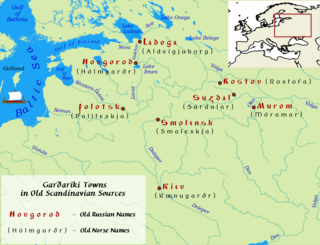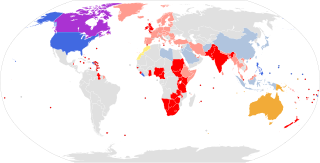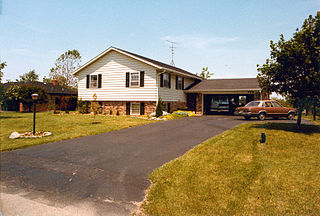In Germanic cosmology, Midgard is the name for Earth inhabited by and known to humans in early Germanic cosmology. The Old Norse form plays a notable role in Norse cosmology.

A garden is a planned space, usually outdoors, set aside for the cultivation, display, and enjoyment of plants and other forms of nature. The single feature identifying even the wildest wild garden is control. The garden can incorporate both natural and artificial materials.

Bocage is a terrain of mixed woodland and pasture characteristic of parts of northern France, southern England, Ireland, the Netherlands, northern Spain and northern Germany, in regions where pastoral farming is the dominant land use.

Garðaríki or Garðaveldi was the Old Norse term used in the Middle Ages for the lands of Rus'. According to Göngu-Hrólfs saga, the name Hólmgarðaríki was synonymous with Garðaríki, and these names were used interchangeably in several other Old Norse stories.

A sty or pigsty is a small-scale outdoor enclosure for raising domestic pigs as livestock. It is sometimes referred to as a hog pen, hog parlor, pigpen, pig parlor, or pig-cote, although pig pen may refer to pens confining pigs that are kept as pets as well. Pigsties are generally fenced areas of bare dirt and/or mud. "Sty" and "pigsty" are used as derogatory descriptions of dirty, messy areas, the word sty deriving from the Proto-Germanic *stiją meaning filthy hovel. There are three contributing reasons that pigs, generally clean animals, create such a living environment:

A backyard, or back yard, is a yard at the back of a house, common in suburban developments in the Western world.
A gord is a medieval Slavonic fortified settlement, usually built on strategic sites such as hilltops, riverbanks, lake islets or peninsulas between the 6th and 12th centuries in Central and Eastern Europe. A typical gord consisted of a group of wooden houses surrounded by a wall made of earth and wood, and a palisade running along the top of the bulwark.
Australian English is a major variety of the English language spoken throughout Australia. Most of the vocabulary of Australian English is shared with British English, though there are notable differences. The vocabulary of Australia is drawn from many sources, including various dialects of British English as well as Gaelic languages, some Indigenous Australian languages, and Polynesian languages.
In common law, the curtilage of a house or dwelling is the land immediately surrounding it, including any closely associated buildings and structures, but excluding any associated "open fields beyond". In feudal times every castle with its dependent buildings was protected by a surrounding wall, and all the land within the wall was termed the curtilage. The term excludes any closely associated buildings, structures, or divisions that contain the separate intimate activities of their own respective occupants, with those occupying residents being persons other than those residents of the house or dwelling of which the building is associated.

Despite the various English dialects spoken from country to country and within different regions of the same country, there are only slight regional variations in English orthography, the two most notable variations being British and American spelling. Many of the differences between American and British/English in the Commonwealth of Nations date back to a time before spelling standards were developed. For instance, some spellings seen as "American" today were once commonly used in Britain, and some spellings seen as "British" were once commonly used in the United States.
A warren is a network of interconnected burrows, dug by rabbits. Domestic warrens are artificial, enclosed establishments of animal husbandry dedicated to the raising of rabbits for meat and fur. The term evolved from the medieval Anglo-Norman concept of free warren, which had been, essentially, the equivalent of a hunting license for a given woodland.

A pen is an enclosure for holding livestock. It may also perhaps be used as a term for an enclosure for other animals such as pets that are unwanted inside the house. The term describes types of enclosures that may confine one or many animals. Construction and terminology vary depending on the region of the world, purpose, animal species to be confined, local materials used and tradition. Pen or penning as a verb refers to the act of confining animals in an enclosure.

In architecture, a quadrangle is a space or a courtyard, usually rectangular in plan, the sides of which are entirely or mainly occupied by parts of a large building. The word is probably most closely associated with college or university campus architecture, but quadrangles are also found in other buildings such as palaces. Most quadrangles are open-air, though a few have been roofed over, to provide additional space for social meeting areas or coffee shops for students.

Compound, when applied to a human habitat, refers to a cluster of buildings in an enclosure, having a shared or associated purpose, such as the houses of an extended family. The enclosure may be a wall, a fence, a hedge or some other structure, or it may be formed by the buildings themselves, when they are built around an open area or joined together.

On a residential area, a front yard or front garden is the portion of land between the street and the front of the house. If it is covered in grass, it may be referred to as a front lawn. The area behind the house, usually more private, is the back yard or back garden. Yard and garden share an etymology and have overlapping meanings.

In Italy, cascina a corte, more simply known as cascina, refers to a type of rural building traditional of the Po Valley, especially of Lombardy and of some areas of Piedmont and Emilia-Romagna.














